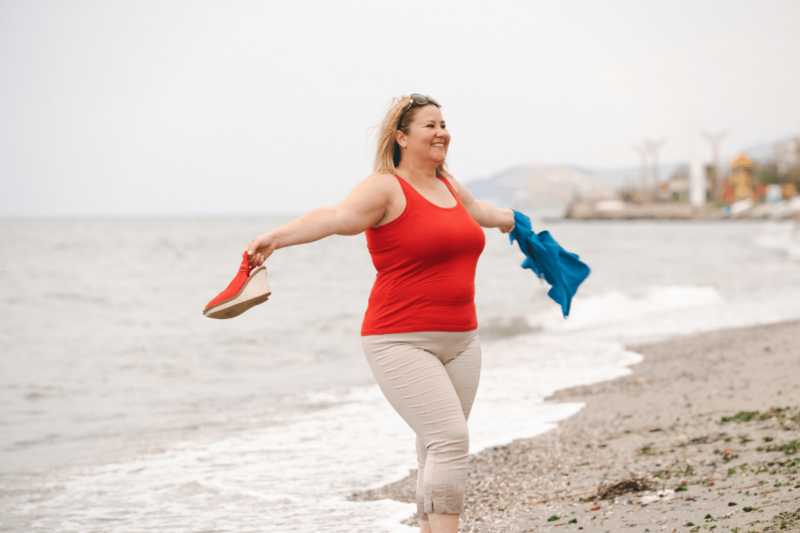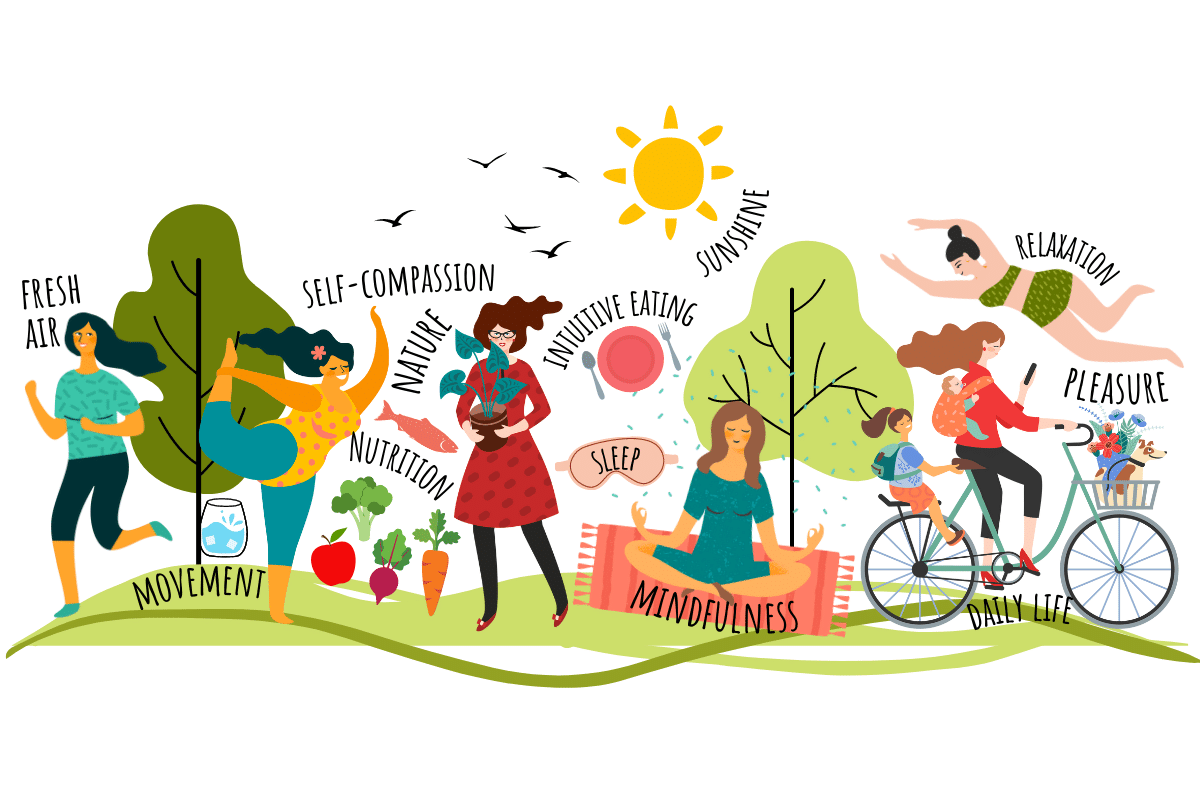Table of Contents

The second edition of my book, “Healthy For Your Life” is now available on Amazon. This new edition is revised and updated as well as expanded, with 80 more pages, new recipes, and selected citations. It also has a new subtitle: “A non-diet approach to optimal well-being.” Here’s are some excerpts from the introduction and from Chapter 1.
Excerpt from Introduction (part 1)
This book was born out of the confusion I see every day in private practice clients, friends, family and readers of my newspaper articles. Not just what to eat, but when to eat, how to eat and why to eat. And then there’s the biggest mystery of all—who are we in relation to food? I totally understand that confusion, because, believe me, I’ve been there myself. We all swim in the waters of diet and “wellness” culture, like it or not, so it’s hard to not be influenced by it to at least some degree.
When it comes to nutrition, I’m a straight shooter (in other words, if a nutrition claim has no evidence to back it up, I’ll say so), but I also know that nutrition, food and eating isn’t black and white — not only do I see the many shades of gray, but I revel in them. When I’m working with patients one-on-one, I aim to help them find the nutrition path that’s right for them, the one that leaves them feeling nourished and peaceful around food, with gentle guidelines instead of rigid rules.
While reading this book isn’t the same as meeting with me in person, I’ve tried to distill some of my best knowledge about nutrition and how we related to food onto these pages. Because I’m just scratching the surface, I’ve included a robust resource list, along with bonus worksheets and other materials.
Some of the worksheets include journaling exercises, and some readers may be wondering if they would benefit from keeping a food journal, especially if they are using this book to guide or inspire some changes to their food choices or eating habits. My answer is “maybe.” I am a big advocate of keeping a “food and feelings” journal that tracks what and when you eat (without getting nitpicky about amounts and definitely without tracking calories or grams of whatever), how your food makes you feel, and how you’re feeling generally. Here are some elements that may be useful to log in a food and feelings journal:
- What you ate and drank (again, no tracking calories or macros)
- When you ate and drank
- How hungry you are when you start eating
- How full/satisfied you are when you finish eating
- Any cravings or non-hunger impulses to eat (boredom, stress, anxiety, etc.)
- Bedtime and wake times
- How well you slept
- Type/amount of physical movement
- Any self-care habits you practiced (adequate sleep, meditation, play, etc.)
- General thoughts or observations about your relationship with food and your body

Excerpt from Introduction (part 2)
In my personal and professional experience, writing down this type of information is useful for two major reasons: it offers you an objective look at your eating patterns (our memories are not as reliable as we think), which can help you notice patterns that aren’t serving you well (like going too long between meals, not eating enough protein, and so on) and it can help you be mindful as you start to form new habits. All of this requires honesty in your journal, of course, which in turn asks that you be compassionate towards yourself if you aren’t thrilled with what your food journal reveals. Remember that awareness of our habits is a vital first step to moving forward and cultivating positive change. No one likes to be judged, so please don’t judge yourself. You’re trying to do your best — we all are.
It should be clear that this is not a diet book, but just in case — this is not a diet book. As I’ll talk about, diets don’t work, but you could still have some food habits that aren’t working for you. That said, if this book inspires you to make some changes — and I hope that it does — make those changes with sustainability in mind. In other words:
- Make changes at a pace that doesn’t overwhelm you.
- Make changes that will enhance your physical and mental well-being.
- Make changes that you’re confident you’ll be happy to maintain for life, or at least for a very long time (otherwise you will have turned this book into a diet).
In keeping with my journalistic nature, I’ve organized this book into five sections: who, what, when, where and how, and why. Those are the key elements of any news story, and the key elements of forming a healthy, nourishing relationship with food.

Are you embodied? (Excerpt from Chapter 1)
HAS THE THOUGHT OF SEEING SOMEONE you haven’t seen for a while filled you with dread because you’ve gained some weight, or maybe aren’t as “in shape” as you were last time you saw them? You know you should welcome the opportunity to spend time with friends or family—especially those you really like—but when negative body image raises its pernicious, ugly head, it can make you feel like hiding and sticking your head in the sand.
If hiding isn’t an option, a common reaction to these feelings is to try to “fix” the problem — the perceived problem being our bodies. But trying to solve bad body image by changing our bodies is putting energy in the wrong place. It’s kind of like trying to get from Point A to Point B by running on a giant hamster wheel forever. It’s making our bodies the scapegoat when the real problem is in our heads — and in society.
Normative discontent
It’s an unfortunate fact: negative body image, or body dissatisfaction, is so pervasive among women that it was coined “normative discontent” back in 1984. In the United States, as many as 84 percent of women exhibit body dissatisfaction, and this can lead to disordered eating, depression, social anxiety, shame, feelings of low self-worth and reduced quality of life.
But eradicating negative body image isn’t enough — you need to replace it with something positive. Body image research has shifted to focus on positive ways of living in the body, such as embodiment. Being embodied is not the same as having low levels of negative body image or having high levels of body satisfaction. Embodiment is the experience of feeling at home in our bodies.

Moving beyond body image
Body “image” implies an outside-in view, with a narrow focus on how we are seen. A focus on liking or being at peace with how we look — and not caring what other people might think about how we look — keeps the focus on how we look. It treats our bodies as objects and keeps us disconnected from them. Embodiment instead puts the focus on how we feel inside our own bodies and how we experience the world as we live in our bodies.
Positive embodiment includes body appreciation — having a generally favorable opinion of your body regardless of appearance — including appreciation for how our bodies function, including physical capabilities, creativity, our senses, and the fact that our hearts beat for us all by themselves. It also includes body image flexibility — being able to experience unkind feelings, thoughts and beliefs about our bodies without letting them stop us from doing things that we truly value. For example, not letting the thought “I don’t like how I look in a bathing suit” stop you from taking a fun water aerobics class or going to the beach with your kids. Another example would be not letting how you feel about your body at the moment dictate whether or not you go out with friends.
What supports embodiment?
As we move through life, certain factors support — or detract from — our ability to feel positive embodiment. One is freedom to move and take up space, including freedom to engage in enjoyable physical activities. This could include women and people in larger bodies feeling that they can be active in public without rude or threatening comments.
Not surprisingly, freedom from violence or abuse is important for feeling at home in our bodies, as is freedom from prejudice, harassment and the feeling that we have to diet or otherwise alter our bodies. Exposure to social experiences that teach, support and model positive mental and physical self-care and encourage connection to our bodies as worthy is also important. So is having experiences that validate and encourage tuned-in, assertive and joyful responses to appetite and sexual desire.
Other factors are having a critical stance towards ideas about how we are “supposed to” look and behave, having empowering relationships, being a part of an equitable community and knowing that our social power isn’t based on our appearance.

Assessing and cultivating embodiment
Here are some questions you can ask yourself that can help you explore your experiences of embodiment:
- What messages did you/do you get about food and your body? How does that make you feel?
- Have you experienced emotional or physical trauma?
- Have you engaged in weight loss dieting? At what age did you start?
- Have you experienced food insecurity?
- Do you engage in physical activity? What types? Do you enjoy it?
- Do you feel connected to your body?
There are many ways to cultivate embodiment. You can start connecting with your body and its desires, including honoring hunger and finding pleasure and satisfaction in food. Learning to trust your body’s natural hunger cues can help you trust more subtle signals, such as your intuition. You can set boundaries around food and body comments from friends and family. You can practice attuned self-care, including rest and solitude when needed, activity and stimulation when needed. Try asking yourself: How is my body doing today? How is my body feeling today? What sensations am I feeling in my body today?
Engaging in enjoyable forms of movement for reasons other than transforming your body — especially if you allow yourself to be in the present moment and actually feel your body — can also build embodiment. Activity that feels like play can be particularly powerful.
Read the rest…buy the book!
Carrie Dennett, MPH, RDN, is a Pacific Northwest-based registered dietitian nutritionist, freelance writer, intuitive eating counselor, author, and speaker. Her superpowers include busting nutrition myths and empowering women to feel better in their bodies and make food choices that support pleasure, nutrition and health. This post is for informational purposes only and does not constitute individualized nutrition or medical advice.
Seeking 1-on-1 nutrition counseling? Carrie offers a 6-month Food & Body program (intuitive eating, body image, mindfulness, self-compassion) and a 4-month IBS management program (low-FODMAP diet coaching with an emphasis on increasing food freedom). Visit the links to learn more and book a free intro call to see if the program is a good fit, and if we’re a good fit!
 Print This Post
Print This Post





More Stories
The One Thing You Should Never, Ever Do if You Have Insulin Resistance and Want to Lose Weight
Tuna Salad Lunch Box – JSHealth
Advanced Wellness Course – Heart Health